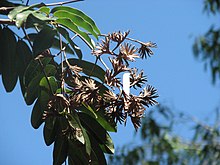
The Anacardiaceae, commonly known as the cashew family or sumac family, are a family of flowering plants, including about 83 genera with about 860 known species. Members of the Anacardiaceae bear fruits that are drupes and in some cases produce urushiol, an irritant. The Anacardiaceae include numerous genera, several of which are economically important, notably cashew, mango, Chinese lacquer tree, yellow mombin, Peruvian pepper, poison ivy, poison oak, sumac, smoke tree, marula and cuachalalate. The genus Pistacia is now included, but was previously placed in its own family, the Pistaciaceae.

Alectryon is a genus of about 30 species of trees and shrubs from the family Sapindaceae. They grow naturally across Australasia, Papuasia, Melanesia, western Polynesia, east Malesia and Southeast Asia, including across mainland Australia, especially diverse in eastern Queensland and New South Wales, the Torres Strait Islands, New Guinea, the Solomon Islands, New Caledonia, New Zealand, Vanuatu, Fiji, Samoa, Hawaii, Indonesia and the Philippines. They grow in a wide variety of natural habitats, from rainforests, gallery forests and coastal forests to arid savannas and heaths.

Flindersia is a genus of 17 species of small to large trees in the family Rutaceae. They have simple or pinnate leaves, flowers arranged in panicles at or near the ends of branchlets and fruit that is a woody capsule containing winged seeds. They grow naturally in Australia, the Moluccas, New Guinea and New Caledonia.

Hakea is a genus of about 150 species of plants in the Family Proteaceae, endemic to Australia. They are shrubs or small trees with leaves that are sometimes flat, otherwise circular in cross section in which case they are sometimes divided. The flowers are usually arranged in groups in leaf axils and resemble those of other genera, especially Grevillea. Hakeas have woody fruit which distinguishes them from grevilleas which have non-woody fruit which release the seeds as they mature. Hakeas are found in every state of Australia with the highest species diversity being found in the south west of Western Australia.
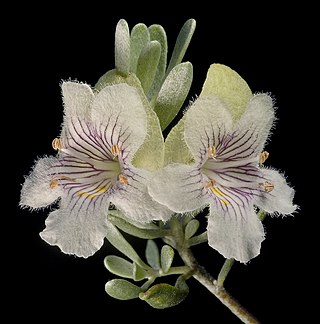
Prostanthera, commonly known as mintbush or mint bush, is a genus of about 100 species of flowering plants in the mint family Lamiaceae, and all are endemic to Australia. Plants are usually shrubs, rarely trees with leaves in opposite pairs. The flowers are arranged in panicles in the leaf axils or on the ends of branchlets. The sepals are joined at the base with two lobes. The petals are usually blue to purple or white, joined in a tube with two "lips", the lower lip with three lobes and the upper lip with two lobes or notched.

Backhousia is a genus of thirteen currently known species of flowering plants in the family Myrtaceae. All the currently known species are endemic to Australia in the rainforests and seasonally dry forests of Queensland, New South Wales and Western Australia.

Brachychiton acerifolius is a large tree of the family Malvaceae endemic to tropical and subtropical regions on the east coast of Australia. It is famous for the bright red bell-shaped flowers that often cover the whole tree when it is leafless. It is commonly known as the flame tree, Illawarra flame tree, lacebark tree, or kurrajong.

Bosistoa is a genus of four species of tree in the family Rutaceae endemic to eastern Australia. They have simple or compound leaves arranged in opposite pairs and bisexual flowers arranged in panicles, each flower with five sepals, five white petals and ten stamens.

Olearia, most commonly known as daisy-bush, is a genus of flowering plants belonging to the family Asteraceae, the largest of the flowering plant families in the world. Olearia are found in Australia, New Guinea and New Zealand. The genus includes herbaceous plants, shrubs and small trees. The latter are unusual among the Asteraceae and are called tree daisies in New Zealand. All bear the familiar daisy-like composite flowerheads in white, pink, mauve or purple.

Pittosporaceae is a family of flowering plants that consists of 200–240 species of trees, shrubs, and lianas in 9 genera. Habitats range from tropical to temperate climates of the Afrotropical, Indomalayan, Oceanian, and Australasian realms. The type genus is Pittosporum Banks ex Gaertn.

Castanospora is a monotypic genus of trees, constituting part of the plant family Sapindaceae. The sole species Castanospora alphandii, commonly known as brown tamarind, grows naturally in the Australian rainforests of north-eastern New South Wales and eastern Queensland as far north as the Wet Tropics rainforests of north-eastern Queensland.
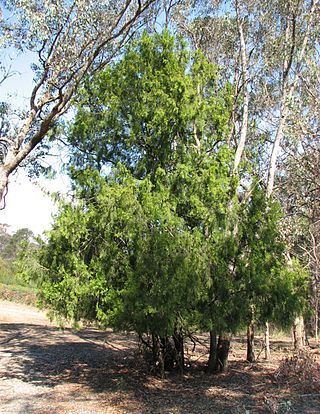
Exocarpos is a genus of flowering shrubs and small trees in the sandalwood family, Santalaceae. They are found throughout Southeast Asia, Australia and the Pacific Islands.
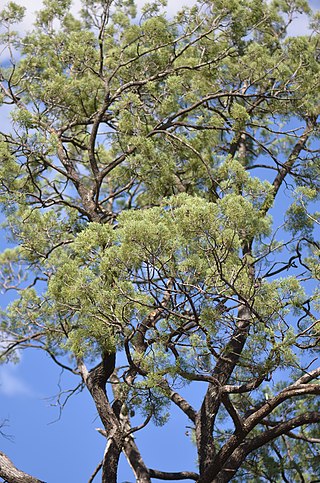
Callitris columellaris is a species of coniferous tree in the family Cupressaceae, native to most of Australia. Common names include white cypress, white cypress-pine, Murray River cypress-pine, and northern cypress-pine. Callitris columellaris has become naturalised in Hawaii and in southern Florida.
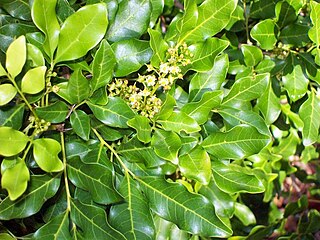
Toechima is a genus of small to medium-sized trees in the plant family Sapindaceae. The species are native to New South Wales, the Northern Territory and Queensland in Australia as well as New Guinea.

Buckinghamia is a genus of only two known species of trees, belonging to the plant family Proteaceae. They are endemic to the rainforests of the wet tropics region of north eastern Queensland, Australia. The ivory curl flower, B. celsissima, is the well known, popular and widely cultivated species in gardens and parks, in eastern and southern mainland Australia, and additionally as street trees north from about Brisbane. The second species, B. ferruginiflora, was only recently described in 1988.
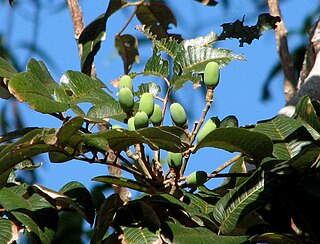
Canarium australianum is a species of trees, native to Australia and Papua New Guinea, of the plant family Burseraceae. Common names include mango bark, scrub turpentine, carrot wood, parsnip wood, Melville Island white beech and brown cudgerie.

Rhus taitensis is a small tree or shrub in the sumac family of plants. It is found from tropical Asia, to Australia and many islands of the Pacific ocean. The chemical tetrahydroxysqualene from dried and ground parts of R. taitensis has in vitro activity against Mycobacterium tuberculosis and the plant has been used in folk medicine locally to treat diarrhea and hearing loss.
Hollandaea is a small genus of plants in the family Proteaceae containing four species of Australian rainforest trees. All four species are endemic to restricted areas of the Wet Tropics of northeast Queensland.
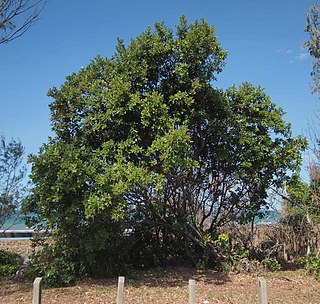
Alectryon connatus, sometimes named hairy alectryon, is a species of small tree in the plant family Sapindaceae.

Ackama paniculosa, synonym Caldcluvia paniculosa, known as the soft corkwood, is a rainforest tree of eastern Australia. It occurs from Ourimbah, Central Coast at 33° S to Eungella National Park in tropical Queensland. Other common names include corkwood, rose-leaf marara, brown alder and sugarbark.
